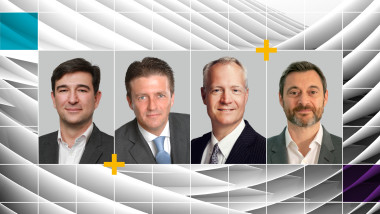Private Equity Secondaries on a Roll
Highlights
- A bumper 2024 for private equity secondaries is on the horizon, amid record new deal backlog and transaction supply which is expected to reach multi-year highs. A relative easing of macro-economic worries and stabilizing pricing levels, together with seller needs for liquidity are expected to drive another year of strong and potentially record-breaking secondary market volume.
- Drivers for GP-led deal supply remain intact, as GPs need to seek alternative ways to generate liquidity for their LPs, providing opportunities to get exposure to trophy assets with an attractive risk-return profile at valuations skewed to the benefit of buyers.
- Competition in the smaller end of the secondary market is lower as many funds have moved to higher deal brackets. Flexstone has stayed true to its original DNA, with relatively small fund and ticket sizes, allowing a highly selective and disciplined investment approach.
Resources
Secondary volumes may hit a new record high
Transaction volumes in the first half of 2023 did not look promising as they continued to be impacted by a stubborn bid-ask spread. Total volume in the first half came in at a disappointing $41bn, or about 20% lower compared to the same period in 2022. As the year progressed, however, average pricing levels stabilized and rebounded slightly from the decade-low levels in 2022. Together with a narrowing bid-ask spread, this provided renewed confidence to market participants and triggered a surge in completed secondary transactions.
“By the first half of 2023, the initial turmoil created by the Ukraine war, with the accompanying inflationary effects, started to ease,” says Kristof Van Overloop, Managing Director at Flexstone Partners. The strong performance of public equities throughout 2023 provided further support to secondary pricing levels, and increasingly drove sellers to market. According to Lazard, LP sales for liquidity purposes rose four-fold in 2023, emphasizing persistent liquidity needs for LPs as exit volumes and distributions slowed down materially.
Flexstone, an affiliate of Natixis Investment Managers and a lower mid-market buyout specialist, expects H2 2023 secondary transaction volume to increase to around $65bn–$70bn, with full-year 2023 volume exceeding $110bn, and perhaps as high as $120bn. That compares favourably with the $103bn of global transaction volume in 2022.
So what is Flexstone’s forecast for 2024? “Intermediaries have all been reporting backlogs building, with new deal supply pipeline at a multi-year high,” says Van Overloop. “So a bumper year 2024 is definitely possible.” The frenetic activity in secondaries is partly based on a more stable macro outlook, expectations that central bank rates have peaked and are forecast to fall throughout the year, and the knock-on effect of stabilizing pricing levels.
Van Overloop says: “We are currently working on a number of mid-market deals and have been seeing some really motivated sellers now.” Whereas the bid-ask spread was closer to 10 percentage points last year, it has since narrowed to 3%–4%, allowing more deals to get done. “Many potential sellers were testing the waters last year. But with the passage of time and continued stubbornly lower distributions, they have now become keen to sell on the secondary market to generate much-needed liquidity”.
GP-led deals providing exposure to trophy assets at attractive discounts
GP-led transaction volume is well-positioned for further growth in an environment of continued slower exit activity and increased LP appetite and need for liquidity. This is increasingly driving GPs to approach the secondary market, launching continuation funds to deliver liquidity options to their LPs and improve from their funds.
Top quality, or so-called trophy assets, are being brought to market, says Van Overloop. “We completed a handful of GP-led transactions last year involving such assets at attractive entry valuations, resulting in substantial day-1 write-ups for us as a buyer, while still allowing to lock in solid returns in the GP’s original fund.” GPs are willing to sell these outperforming assets because they have typically outperformed their original underwriting case and fulfilled the objective for the fund. Secondly, these funds are often fully invested and lack the available capital to continue to support a portfolio company that requires further capital to accelerate organic or bolt-on M&A growth.
Selling LPs are accepting a meaningful discount to the latest reported value or intrinsic value, but may still be getting a good exit and – more importantly in the current market – are getting liquidity. Despite not achieving price maximalisation, approximately 80% of LPs chose liquidity and elected to sell into continuation funds in 2023, roughly in line with recent years.
As a consequence, secondary buyers such as Flexstone can get exposure to coveted assets with strong GP alignment and a substantially de-risked value creation trajectory. Asset and manager selection remains critically important though. “Our targeted and selective investment approach focused on partnering with GPs with whom we have close and longstanding relationships, allows us to select and only pursue those GP-led opportunities where we have differentiated insights and where we can position ourselves favourably to secure our desired allocation,” says Van Overloop.
The increasing share of (lower) mid-market GP-led transactions positions Flexstone well for continued strong deployment to this secondary transaction type.
Lower competition, less intermediation, and more inefficiencies to exploit
The smaller end of the secondary market, with ticket sizes below €50 million, is characterized by lower competition and low to no leverage, resulting in more attractive pricing levels. Several of Flexstone’s historical peers have raised ever larger funds over the years and have moved into higher deal brackets, now targeting much larger portfolio transactions.
Van Overloop says: “We have remained disciplined with consistent and relatively small fund sizes and have stayed true to our DNA with ticket sizes of about €15 million to €25 million on average.” As a result, Flexstone can remain highly selective and choose only the high-conviction deals it wants to pursue. This stock picking-like approach is a very different way of approaching the market compared with the deployment pressure faced by large cap secondary funds that cannot afford to be as selective, encouraging aggressive bidding behaviour and higher pricing.
“The lower segment of the market has been abandoned by many of our original peers over the years,” says Van Overloop. “Five or seven years ago, we had more competition. Of course we want to deploy capital, but we are in no hurry,” he adds.
The lower end of the secondary market is also less intermediated, with less information available or disclosed in GP fund reports, providing great opportunities for experienced secondary buyers like Flexstone. This part of the market is more dependent on direct GP and LP relationships rather than advisers or intermediaries. “Our deals tend to be sourced through GPs we have known for many years,” says Van Overloop. “Often we are existing LPs in their funds, or may be on the Board of the selling fund.” As a result, Flexstone often hears about an LP looking to sell ahead of the market and can position itself favourably and pre-empt an intermediated transaction. Or it may learn early on that the GP itself may be considering a GP-led transaction.
Similarly, Flexstone has close relationships with many LPs, with whom it has transacted several times over the years. Even in today’s market, Flexstone continues to have proprietary or bilateral discussions with many of these LPs, who also value speed and certainty of execution – in addition to pricing – that ultimately end in successfully closed transactions.
“We are looking for the right funds we want to own, managed by leading GPs where we have strong conviction and underlying portfolio companies that are performing well and typically are at an inflection point in their value creation. When all of that comes together, we can build the conviction we require,” Van Overloop says. “GP relationships are at the core of our secondary strategy and fundamentally underpin Flexstone’s competitive edge”.
The in “mosaic” LP-interest deals
With the relative stabilisation of the macro environment and a recovery in public equities, followed by a stabilization of pricing in the secondary market throughout the year, 2023 witnessed the comeback of large LP portfolio transactions. These were largely absent in 2022.
Many of these large LP portfolios transacted in “mosaic” solutions, whereby a seller trades with several buyers, each cherry-picking different lines or subsets of the portfolio. “This creates opportunities for Flexstone, says Van Overloop. “We may only have appetite for two or three small- or mid-market funds out of a large €1bn-plus portfolio, and a mosaic deal can create actionable opportunities for us to get something done.”
It is not always easy to extract a few lines out of a larger portfolio as sellers typically prefer to transact with a single buyer or, at least, a limited buyer group to keep the closing process as efficient as possible. Close and longstanding GP relationships and differentiated portfolio insights are required to extract single funds from a portfolio.
“GPs have become increasingly restrictive on their transfer policy, and we have seen several situations in the past years where a GP did not provide transfer consent to the portfolio buyer, and in turn approached a handful of close existing investors including ourselves,” says Van Overloop. That can create compelling deal dynamics with a very tight timeline and a frustrated seller that wants a full solution for their portfolio.
All else being equal, these situations can create highly actionable opportunities to acquire targeted fund names, typically at opportunistic pricing levels.
Trading performance under the microscope
Notwithstanding the relative easing of some of the macroeconomic concerns and woes over the past several quarters, in-depth diligence of targeted funds and portfolio companies remains key to Flexstone’s strategy. Van Overloop says: “We dig even deeper than before in terms of our detailed portfolio company assessment and diligence in our underwriting, zooming in on current trading performance and outlook, but also assessing the industry and end-markets these companies are operating in.”
This is particularly relevant amid evidence of some softer trading performance across certain markets. A year ago, GPs were largely positive – there were few worries about the impact of inflation on customer demand. “But 12 months down the line, we are seeing more mixed views,” Van Overloop says. In some industries, portfolio company performance has suffered and some GP fund valuations are somewhat stale, meaning seller asking prices can be too aggressive.
“We favour GPs with conservative valuations on their books and a strong trajectory of outperforming company performance forecasts,” adds Van Overloop.
Opportunistic portfolio construction approach creates flexibility
While Flexstone’s deployment volume in 2023 was tilted towards GP-led secondaries, it expects a bumper year for LP-interest opportunities in 2024.
“We remain opportunistic across secondary transaction types in terms of GP-leds vs LP-interest deals,” says Van Overloop. “We believe both transaction types have their merits and a role in portfolios. At times the best relative value can be found in the LP-interest segment, at other times there is better value to be had across GP-leds.”
Both transaction types have different characteristics and attributes, but Flexstone’s fundamental approach is the same for each. Whereas many of its peers raise dedicated pools of capital for either GP-led funds or LP-interest transactions, Flexstone believes pursuing both in the same vehicle makes sense given their complementary nature.
“By opportunistically targeting both transaction types, we can ensure the opportunity set at any one time is maximized. This provides a competitive edge in terms of new deal sourcing and searching for quality funds at the best relative value available in the market over peers who can only look at one type,” concludes Van Overloop.
Published in March 2024
An affiliate of Natixis Investment Managers
Flexstone Partners, SAS – Paris
Investment management company regulated by the Autorité des Marchés Financiers. It is a simplified stock corporation under French law with a share capital of 1,000,000 euros Under n° GP-07000028 –Trade register n°494 738 750 (RCS Paris)
5/7, rue Monttessuy,
75007 Paris
www.flexstonepartners.com
Flexstone Partners, SàRL – Geneva
A manager of collective assets regulated by the Swiss Financial Market Supervisory Authority (“FINMA”). It is a limited liability company with a share capital of 750 000 CHF.
Trade register n° CH-112-212.153
8 chemin de Blandonnet
Vernier 1214 Geneva
Switzerland
Flexstone Partners, LLC - New York
Delaware corporation, registered with the United States Securities and Exchange Commission as an investment adviser
575 Fifth Avenue, 22nd Floor
New York, NY 10017
Flexstone Partners, PTE Ltd - Singapore
OUE Downtown 2 #24-12
6 Shenton Way Singapore 068809
Natixis Investment Managers
RCS Paris 453 952 681
Share Capital: €178 251 690
43 avenue Pierre Mendès France
75013 Paris
www.im.natixis.com





 Performance Fees in DC Pensions
Performance Fees in DC Pensions
 The Alternative Outlook for 2024
The Alternative Outlook for 2024
 Private Equity Secondaries Ready to Ride Rough Markets
Private Equity Secondaries Ready to Ride Rough Markets
 Private Equity: Reducing Uncertainty
Private Equity: Reducing Uncertainty